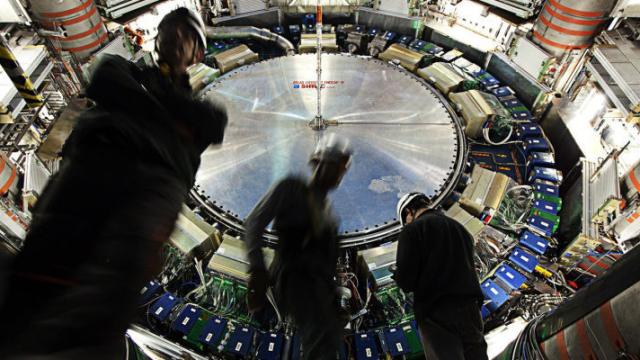Rumours are swirling again among physicists, but this time they’re not about gravitational waves. Instead, hopes are fading that two separate, but complementary, experiments at the Large Hadron Collider may have discovered a possible new particle.
Image: CERN
Last December, LHC physicists announced that they’d found tantalising traces of an exotic particle not predicted by the Standard Model of particle physics — perhaps a heavier cousin of the Higgs boson, or the elusive graviton, a quantum carrier of the force of gravity. Neither reported finding was solid enough to claim discovery, but both experiments reported hints of a signal in exactly the same spot in the data, which was promising.
At the time, I (and others) cautioned that it was likely that those hints of a signal would disappear as more data was added to the analytical mix:
Physicists know precisely how many of each type of particle they should expect to see in the data; any excess above a certain threshold is a promising hint of possible new physics (like a new particle).
When all’s said and done, those signals show up as unexpected “bumps” in the data — that’s why experimental particle physicists often call themselves “bump hunters.” The thing is, it’s easy to see small “bumps” that aren’t really there; statistical artifacts crop up all the time, particularly during early data runs. The more data you have, the better the statistical analysis. If a small “bump” persists and gets bigger — the signal gets stronger — it’s much more likely that it’s the signature of a bona fide new particle.
The LHC began analysing a ton of new data in May. Unfortunately, Science News is reporting that it’s looking like the former case — a statistical artefact — is the more likely scenario. That’s according to rumours on Twitter and on two physics blogs. Noting that the field is fast approaching a crucial crossroads, physicist Peter Woit wrote, “If the bump is there, the field will be revolutionised and dominated by this for years, if it’s not, we’re back to the usual frustrating grind.”
Rumor: 750 GeV diphoton bump is going away as more data is collected by LHC. Most likely, excess seen in 2015 was just statistical fluke.
— Jester (@Resonaances) June 21, 2016
The official stance is that we can’t be sure until all the data is in later this winter. “Currently the data are still being recorded and analysed and it is too early to conclude,” Beate Heinemann of the University of California, Berkeley, and deputy spokesperson for the ATLAS experiment at the LHC, told Science News. “We hope to be able to present the new data in early August,” during a high energy physics conference (ICHEP 2016) in Chicago.
